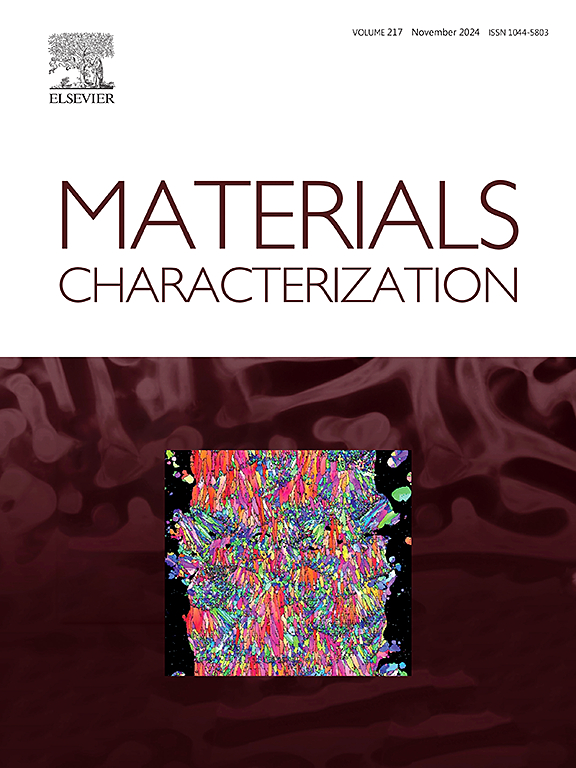Elucidating the contribution of deformation-induced martensitic transformation and deformation twinning to dynamic strain aging in Fe-Cr-Ni metastable austenitic stainless steel
IF 4.8
2区 材料科学
Q1 MATERIALS SCIENCE, CHARACTERIZATION & TESTING
引用次数: 0
Abstract
A generally accepted long-range diffusion model based on dynamic strain aging (DSA) cannot explain the occurrence of the serrated flow below 200 °C in austenitic steels and other face-centered cubic (FCC) alloys. In this paper, new mechanisms for the serrated flow as a result of deformation-induced α′-martensitic transformation (DIMT) and deformation twinning (DT) are presented in a Fe-15Cr-9Ni metastable austenitic steel. Herein, uniaxial tensile tests were conducted at temperatures varying from 20 to 100 °C with different strain rates (1 × 10−6-1 × 10−3 s−1). The dominant deformation modes evolved from DIMT to DT as the tensile temperature grew. Serrated flow does not occur during tensile deformation at 100 °C dominated by DT, owing to the slow diffusion of carbon (C) atoms in the austenite. The serrated flow during deformation at 20 °C depends on the interaction between the waiting time of dislocations at α′/γ interfaces and the diffusion time of C atoms from α′-martensite to the interfaces. DIMT can provide an accelerated diffusion path for C atoms, effectively reducing the diffusion time. The occurrence of DSA still requires the uniformly distributed fine α′-martensite at a strain rate lower than 1 × 10−5 s−1 because the increased fraction of α′/γ interfaces provides abundant obstacles to dislocation motion. Although DIMT is significantly suppressed at 50–75 °C, the DSA effect can still be induced by the synergistic effect of DIMT and DT at a strain rate lower than 2.78 × 10−4 s−1. DIMT providing obstacles to dislocation motion at α′/γ interfaces is a prerequisite, and then subsequent activation of twins at the α′/γ interface is required. The high-density deformation twins nucleated at α′/γ interfaces lead to an increase in waiting time of dislocations at the interfaces, which contributes to the DSA phenomenon.
形变诱导马氏体相变和形变孪晶对Fe-Cr-Ni亚稳奥氏体不锈钢动态应变时效的影响
基于动态应变时效(DSA)的远程扩散模型不能解释奥氏体钢和其他面心立方(FCC)合金在200℃以下出现的锯齿状流动。本文提出了形变诱导α′-马氏体相变(DIMT)和变形孪晶(DT)在Fe-15Cr-9Ni亚稳奥氏体钢中产生锯齿状流动的新机制。在此,单轴拉伸试验在20至100°C的温度范围内进行,并采用不同的应变速率(1 × 10−6-1 × 10−3 s−1)。随着拉伸温度的升高,主要的变形模式由DIMT向DT演变。由于碳(C)原子在奥氏体中的扩散缓慢,在100℃以DT为主的拉伸变形过程中不发生锯齿状流动。20℃变形时的锯齿状流动取决于α′/γ界面位错等待时间和C原子从α′-马氏体向界面扩散时间的相互作用。DIMT可以为C原子提供加速扩散路径,有效缩短扩散时间。在低于1 × 10−5 s−1的应变速率下,由于α′/γ界面的增加为位错运动提供了丰富的障碍,DSA的发生仍然需要均匀分布的细小α′-马氏体。虽然DIMT在50-75°C时被明显抑制,但在低于2.78 × 10−4 s−1的应变速率下,DIMT和DT的协同效应仍然可以诱导DSA效应。在α′/γ界面上提供位错运动障碍是DIMT的先决条件,然后需要在α′/γ界面上激活孪晶。在α′/γ界面处形核的高密度变形孪晶导致界面位错等待时间延长,从而导致DSA现象的发生。
本文章由计算机程序翻译,如有差异,请以英文原文为准。
求助全文
约1分钟内获得全文
求助全文
来源期刊

Materials Characterization
工程技术-材料科学:表征与测试
CiteScore
7.60
自引率
8.50%
发文量
746
审稿时长
36 days
期刊介绍:
Materials Characterization features original articles and state-of-the-art reviews on theoretical and practical aspects of the structure and behaviour of materials.
The Journal focuses on all characterization techniques, including all forms of microscopy (light, electron, acoustic, etc.,) and analysis (especially microanalysis and surface analytical techniques). Developments in both this wide range of techniques and their application to the quantification of the microstructure of materials are essential facets of the Journal.
The Journal provides the Materials Scientist/Engineer with up-to-date information on many types of materials with an underlying theme of explaining the behavior of materials using novel approaches. Materials covered by the journal include:
Metals & Alloys
Ceramics
Nanomaterials
Biomedical materials
Optical materials
Composites
Natural Materials.
 求助内容:
求助内容: 应助结果提醒方式:
应助结果提醒方式:


